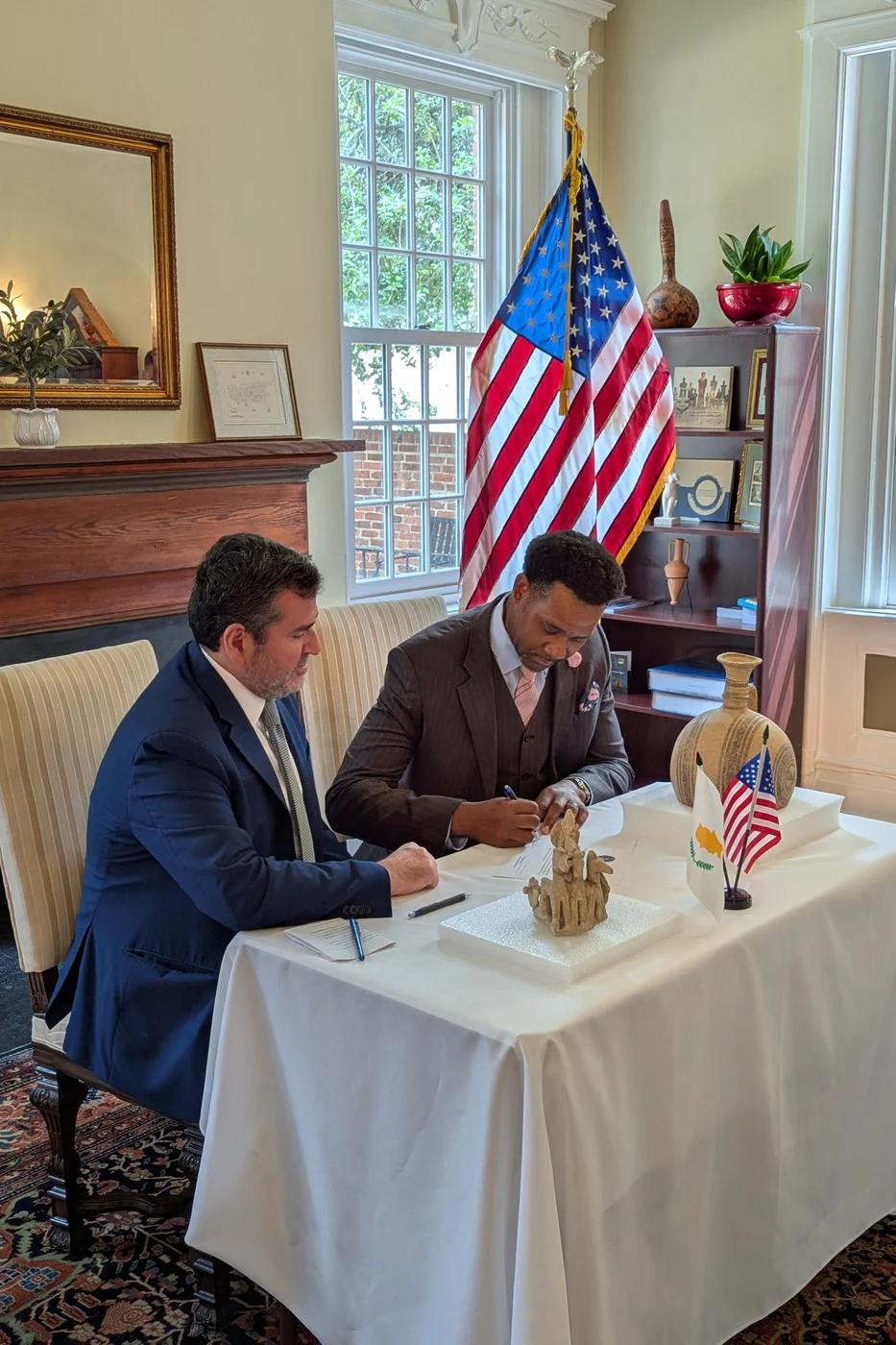FBI Returns Ancient Artifacts to the Cypriot Government
Chariot sculpture and flask are each estimated to be over 2,600 years old

Ambassador of the Republic of Cyprus in the United States Evangelos Savva and FBI International Operations Division Section Chief David Lewis at the repatriation ceremony in Washington, D.C., on August 4, 2025.
For centuries, antiquities and cultural property have been taken from the people of Cyprus, a Mediterranean island with a rich, ancient history. However, good actors have been working to bring these invaluable treasures home.
The FBI, working closely with the Cypriot government and the Department of Justice Office of International Affairs, as well as cooperation from an art gallery in New York, returned two ancient Cypriot artifacts during a repatriation ceremony at the Embassy of Cyprus in Washington, D.C., on August 4, 2025. The artifacts consist of a terracotta quadriga chariot sculpture and a biochrome flask, each estimated to be over 2,600 years old.
"Pieces like these are considered protected cultural property and represent valuable moments in Cyprus’ history," said FBI New York Special Agent Matt. "Returning these antiquities to the government of Cyprus’ possession will allow future generations to better understand their cultural identity and heritage."

The quadriga is a chariot drawn by four horses that serves as an emblem of triumph. This quadriga sculpture is from the Cypro-Archaic period (around 600 B.C.E.). In the chariot box are two figures, a warrior and a charioteer, both wearing helmets. There are three horses—the fourth missing—who wear head covers. Chariots from Cyprus had an active use in battle, and the dedication of quadriga models in sanctuaries suggests they may have also had religious significance.

The bichrome flask, from the Cypro-Geometric III/Cypro-Archaic I period (around 750 B.C.), has a barrel-shape body, narrow cylindrical neck, and flaring mouth. There is a ridge around the lower neck and a vertical “strap handle” from the ridge to the shoulder of the flask. The flask is decorated with painted red and black concentric bands on both sides, encircling a geometric cross in the center. These types of flasks were likely offerings placed in tombs.
"These objects often hold deep historical, spiritual, and cultural significance, carrying the stories and identity of the communities they belong to. Their loss represents a wound in both the memory and heritage of the country.
FBI New York Special Agent Matt
This case came to the FBI’s attention by way of a mutual legal assistance treaty request from the Cyprus Police’s Office of Combating Illegal Possession and Trafficking of Cultural Goods. The Cyprus government had been investigating the illegal sale and possession of two Cypriot antiquities found on a New York art gallery website and called on the FBI to take a closer look.
That's when the FBI's Art Crime Team was called in to investigate. The Art Crime Team is a highly specialized unit of approximately 20 agents across the United States who are tasked with investigating all matters related to art, whether it be theft of artwork, fraud, forgery, or, in this case, antiquities and cultural property trafficking.
The FBI identified the owning gallery, Art for Eternity, and explained that the antiquities in question were believed to have been illegally looted from the country of Cyprus. The gallery owners turned over the items to the government of Cyprus at a financial loss to themselves.
"Art for Eternity voluntarily turned both artifacts over, believing that the cultural importance was more significant than the monetary value," said Matt. "Their cooperation demonstrates the importance of professional due diligence and partnerships between law enforcement and the private sector in combating the sale of illegally obtained or fraudulent cultural property. The gallery owners’ appreciation of the art was truly inspiring, and their assistance shows their continuing commitment to ethical stewardship and international collaboration."
While the art crime market worldwide is often propelled by illicit monetary and financial gain, this case is a reminder that one cannot put a price on artifacts that represent the history of a people. As Matt explained, "Returning art and cultural property to its rightful owners is not just a legal duty but a moral imperative."
"These objects often hold deep historical, spiritual, and cultural significance, carrying the stories and identity of the communities they belong to. Their loss represents a wound in both the memory and heritage of the country. Repatriating these items restores justice, preserves cultural continuity, and allows history to be told truthfully from its source."
The artifacts currently reside at the Embassy of Cyprus in Washington, D.C. They will eventually be shipped back to the Republic of Cyprus, where they will be displayed in a future cultural heritage museum.

Map of Cyprus and neighboring countries.
Art Crime
Art and cultural property crime—which includes theft, fraud, looting, and trafficking across state and international lines—leads to billions of dollars in losses every year.




